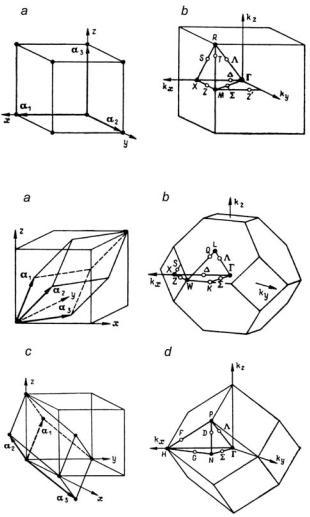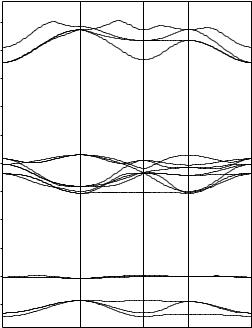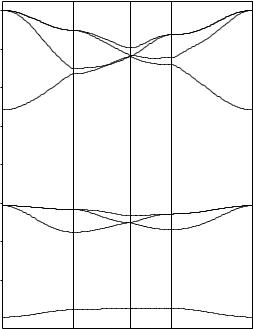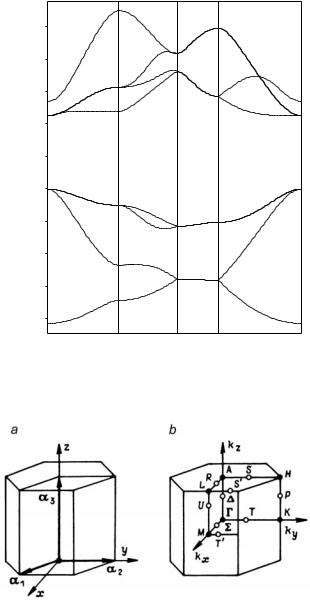
Quantum Chemistry of Solids / 13-Symmetry and Localization of Crystalline Orbitals
.pdf
3
Symmetry and Localization of Crystalline Orbitals
3.1 Translation and Space Symmetry of Crystalline Orbitals.
Bloch Functions
3.1.1 Symmetry of Molecular and Crystalline Orbitals
In a previous chapter we considered the symmetry of a crystalline structure for fixed nuclei positions. The aim of the first-principles approaches in quantum chemistry is to calculate the properties of molecules and crystals without the use of empirical parameters. In principle, all the particles–electrons and nuclei–should be involved in such calculations. In fact, the solution of this complicated task is simplified in the Born–Oppenheimer approximation ( also called the adiabatic approximation). In the first stage the electronic subsystem is studied for di erent nuclear configurations to calculate the potential-energy surface and to find the optimized atomic positions corresponding to the minimal total energy per primitive cell. The nuclear motion can be studied a posteriori, by considering the electronic energy surface as an external potential. Quantum chemistry of solids concerns mainly those physical and chemical properties of solids that depend on the electronic structure. The problem of nuclear motion is solved in approaches using molecular-dynamics methods [26]. These approaches (not considered in this book) allow the study of thermodynamic and transport properties of solids and deserve a separate monograph. The calculations of the electronic subsystem in the adiabatic approximation are always connected with the choice of the electronic Hamiltonian. Formally, the symmetry of the electronic Hamiltonian may di er from the symmetry of the nuclear configuration. However, in the case of crystalline solids the approximate electronic Hamiltonians are usually chosen in such a way that the translational and point symmetry of a crystal is maintained. In Chapters 4–6 we consider in more detail two of the mostly popular approximate methods of many-electron systems description – Hartree–Fock method and the density-functional theory. In both approaches the approximate many-electron function is introduced in such a way that the electron subsystem calculations are made for one-electron wavefunctions. The latter are known as molecular orbitals in molecules and crystalline orbitals in crystals. The symmetry of the electronic Hamiltonian ensures that orbitals (one-electron functions for many-electron systems) transform according to the irreducible representations of point groups for molecules and space groups for crystals.
48 3 Symmetry and Localization of Crystalline Orbitals
ˆ
Let the wavefunction ϕ(r) depend on the coordinates of only one electron, H is a Hamiltonian operator and E the energy of the eigenstate ϕ(r). The function ϕ(r) satisfies the time-independent equation
ˆ |
(3.1) |
H(r)ϕ(r) = Eϕ(r) |
ˆ
The transformation g is said to be a symmetry operation of the Hamiltonian H if
ˆ −1 ˆ ˆ ˆ
H(g r) = H(gr), i.e. if H is invariant under g. Symmetry operations g that leave H invariant form a group. This group is called the symmetry group of the Hamiltonian or of the Schrodinger equation (3.1).
ˆ
We introduce in the linear vector space L of functions ϕ(r) the operators gˆ = D(g)
as
Dˆ (g)ϕ(r) = gϕˆ (r) = ϕ(g−1r) |
(3.2) |
The operators gˆ are linear and the correspondence g → gˆ is preserved in the composition law:
gˆ2gˆ1ϕ(r) = gˆ2ϕ(g1−1r) = ϕ(g1−1g2−1r) = ϕ((g2g1)−1r) |
(3.3) |
ˆ |
|
Hence, the set of operators D(g) = gˆ(g G) is a rep of G and L is the space of this |
|
ˆ |
|
rep. If g G is a symmetry operation of the Hamiltonian operator H then |
|
H(ˆ r)ˆgϕ(r) = H(ˆ r)ϕ(g−1r) = Eϕ(g−1r) = gEϕˆ (r) = gˆHˆ ϕ(r) |
(3.4) |
ˆ
This relation holds for any eigenfunction of H and for all linear combinations of the eigenfunctions, i.e. for any function in the linear vector space L. Therefore, the following operator relation may be written:
ˆ ˆ ˆ ˆ ˆ ˆ |
(3.5) |
gˆH = Hˆg, D(g)H = HD(g), g G |
This expresses in mathematical form the symmetry properties of the Hamiltonian of a quantum mechanical system.
We choose in the space L a symmetry-adapted basis ϕαiµ(r), where the index i = 1, 2, . . . , n labels the basis functions of the irrep α and the index µ distinguishes
ˆ
independent basis functions of equivalent irreps. The matrices of the operators D(g) have in this basis a quasidiagonal structure
Diαµ;jβν (g) = Dij(α)δαβ δµν |
(3.6) |
We write the operator relation (3.5) in the chosen basis using the quasidiagonal form (3.6) of matrices
i |
Hiαµ,i βν Di(βj)(g) = i |
Dii(α)(g)Hi αµ,jβν |
(3.7) |
or |
Hαµ,βν D(β)(g) = D(α)(g)Hαµ,βν |
(3.8) |
|
|
|||
where the notation Hαµ,βν is introduced for matrices with matrix elements (Hαµ,βν )ii
= Hiαµ,i βν .
In accordance with Schur’s Lemmas for irreducible representations
3.1 Translation and Space Symmetry of Crystalline Orbitals. Bloch Functions |
49 |
Hαµ,βν = Hµν(α)E for β = α |
(3.9) |
and |
|
Hαµ,βν = 0 for β =α |
(3.10) |
where E is an nα ×nα unit matrix. Hence, in the symmetry-adapted basis the matrix H of the Hamiltonian has quasidiagonal structure (Wigner’s theorem)
Hiαµ,jβν = Hµν(α)δij δαβ |
(3.11) |
|
The block H(α) is composed of matrix elements |
|
|
Hµν(α) = |
ϕiµα (r) Hˆ ϕiνα (r)dr |
(3.12) |
does not depend on the index i = 1, 2, . . . , nα and is repeated nα times in the matrix
ˆ
H of the Hamiltonian H.
In the symmetry-adapted basis the diagonalizing of the matrix H is reduced to the diagonalizing of its diagonal blocks. Every eigenvalue of the matrix H(α) is repeated nα
ˆ
times in the total list of the eigenvalues of the operator H. From the above discussion
ˆ
it also follows that the eigenfunctions of the Hamiltonian H corresponding to the
ˆ
same eigenvalue are the basis functions of an irrep of the symmetry group G of H (in the absence of accidental degeneracy that is not due to the symmetry) and the degeneracies of eigenvalues are equal to dimensions of the irreps of G (also in the absence of accidental degeneracy). Thus, the eigenstates ϕ(r) and their eigenvalues
ˆ
may be labeled by the irreps of the symmetry group G of the Hamiltonian H.
The symmetry properties of molecular orbitals and the degeneracy of the corresponding eigenvalues are defined by the irreducible representations of the point groups. The tables of these irreps characters are published in many books [13, 27] and their notations are well known and as a rule unambiguous. The energy-level degeneracy is usually 1 (a, b irreps), 2 (e irreps) and 3 (t irreps). As an exclusion, the icosahedral point symmetry group of the fullerene molecule C60 has 4- and 5-dimensional representations (g and h irreps, respectively). The first-principles LCAO calculations of the molecular systems are usually made directly without the application of the Wigner theorem, the symmetry of molecular orbitals is used mainly for their classification and interpretation of the results obtained. However for a large number of basis functions the diagonalizing of the matrix H becomes di cult, time-consuming work. Use of a symmetry-adapted basis in such a case can be useful even for molecular systems.
For crystalline solids the translation symmetry of the Hamiltonian is taken into account in any electronic-structure calculations as it allows calculations to be made for the basis connected only with the primitive unit cell. In the translation-symmetry- adapted basis the matrix H has a quasidiagonal structure with identical blocks related to an irrep k of the translation symmetry group T. As the latter is Abelian its irreps are one-dimensional. The translation symmetry adapted functions are known as Bloch functions and numbered by wavevector k. Use of the point symmetry of a crystal allows the number of Bloch functions calculated to be decreased and further blockdiagonalization of Hamiltonian of a crystal to be made.
The space symmetry of crystalline orbitals is defined by irreducible representations of space groups. As will be shown in the next sections the structure of these irreps is

50 3 Symmetry and Localization of Crystalline Orbitals
more complicated than in the case of point groups. The dimensions of the space-group irreps and the corresponding degeneracy of energy levels are also di erent from those for point groups. In versions CRYSTASL–98,03,06 computer codes the automatic full space group symmetry adaptation of LCAO is included [28]. It is particularly e cient for crystals with high symmetry containing many atoms in the primitive unit cell, for example, a cubic crystal of pyrope with 80 atoms in the cell [29].
The time-reversal symmetry of the crystalline Hamiltonian introduces an addi-
ˆ
tional energy-level degeneracy.Let the Hamiltonian operator H be real. The transition in the time-dependent Schrodinger equation to a complex-conjugate equation with simultaneous time-inversion substitution
i |
∂ϕ(r, t) |
= Hˆ ϕ(r, t), i |
∂ϕ (r, −t) |
= Hˆ ϕ (r, |
− |
t) |
(3.13) |
|
∂t |
∂t |
|||||||
|
|
|
|
|
shows that the functions ϕ(r, t) and ϕ (r, −t) are solutions of the same timedependent Schrodinger equation. This combined operation (complex conjugation + time inversion) is called the time-reversal transformation. Applying this operation to the time-independent Schr¨odinger equation for the time-independent part of stationary-state wavefunctions
Hˆ ϕ(r) = Eϕ(r), Hˆ ϕ (r) = Eϕ (r) |
(3.14) |
ˆ
we see that ϕ(r) and ϕ (r) are the eigenfunctions of the same real operator H belonging to the same eigenvalue E. So with respect to the time-independent part of stationary states ϕ(r) the time-reversal operator reduces to a simple complex conjugation
Kˆ ϕ(r) = ϕ (r) |
(3.15) |
ˆ
Let ϕi (i = 1, 2, . . . , n) be eigenfunctions of a real Hamiltonian H belonging to an eigenvalue E and also be the basis of a unitary irrep D(g) of its symmetry group
ˆ ˆ
G(g G). The functions Kϕi = ϕi are also eigenfunctions of H belonging to the same eigenvalue E, but transforming according to the irrep D (g) [13]. The irreps D(g) and D (g) may be either equivalent or inequivalent. The functions ϕi and ϕi may be linearly dependent or linearly independent. There are three cases: 1) the functions ϕi and ϕi are linearly dependent and are bases of equivalent irreps ; 2) the functions ϕi and ϕi are linearly independent and transform according to inequivalent irreps; 3) the functions ϕi and ϕi are linearly independent and are bases of equivalent irreps. In cases 2 and 3 the eigenvalue E belongs to 2n states ϕi and ϕi . They form a basis of the rep of the group G that is the sum of two irreps D(g) and D (g) of the same dimension n. Thus, the degeneracy of the eigenvalue E doubles with respect to that caused by the symmetry group in the space. In case 1, there is no additional degeneracy. In tables of irreps of space groups the complex conjugate irreps are usually united in one so-called physically irreducible rep. When analyzing the degeneracy of one-electron energy levels in crystals it is necessary to take into account the timereversal symmetry. In particular, even in the case when the point-symmetry group F of a crystal does not include inversion the complex conjugated crystalline orbitals with wavevectors k and −k correspond to the same energy eigenvalue.
3.1 Translation and Space Symmetry of Crystalline Orbitals. Bloch Functions |
51 |
3.1.2 Irreducible Representations of Translation Group. Brillouin Zone |
|
The group T of pure translations ta of an infinite lattice is a group of infinite order. By introducing cyclic boundary conditions one assumes that the infinite crystal consists of equivalent blocks in the form of parallelepipeds having sides A1 = N1a1, A2 = N2a2, A3 = N3a3. It is assumed that the points of di erent blocks connected by
translations are physically equivalent, i.e. tNj = t0. The large positive number N =
Aj
N1N2N3 defines the size of each block, also called the main region of a crystal (this block contains N primitive unit cells in the cyclic model of a crystal). Only the finite-
order group T(N ) (modulo translations Al, A2, A3) of N translations an = |
3 |
i=1 niai |
|
inside the main region is considered when generating the irreps of the |
translation |
|
group. Because this group is Abelian all its irreps are one-dimensional. Moreover, the group T(N ) is a direct product of groups T(N1), T(N2) and T(N3), as all the translations tan commute. Each group T(Ni) of Ni translations tnian has Ni one-dimensional
irreps Dj (t |
niai |
), j = 1, 2, . . . , N , satisfying the condition Dj (t |
an |
) |
Nj = Dj (t |
Nj an |
) = |
|||||||||||||
|
|
|
|
|
|
|
i |
|
|
|
|
|
|
|
|
|
||||
Dj |
(t0) = 1. Taking D |
j |
(tai ) = exp(−2πipj /Nj ) (where pj is an |
integer) one satisfies |
||||||||||||||||
|
|
|
|
|
|
|
|
|||||||||||||
this condition. The integer p |
= 0, 1, . . . , Nj |
1(i = 1, 2, 3) denotes di erent irreps of |
||||||||||||||||||
the translation group T |
(Ni ) j |
|
(p1−p2p3) |
|
|
|
|
|
|
|
|
|
(N ) |
|||||||
. The irrep D |
|
|
(tan ) of the translation group T |
|||||||||||||||||
can be written as |
|
|
|
|
|
|
|
|
|
|
|
|
|
|
|
|
||||
|
|
D(p1p2p3)(tan ) = exp [−2πi(p1n1/N1 + p2n2/N2 + p3n3/N3)] |
(3.16) |
|||||||||||||||||
There are N = N |
1N2N3 |
sets of integers p1, p2 |
, p3 |
(p |
= 0, 1, . . . , N |
− |
1) that are used |
|||||||||||||
|
|
|
|
|
i (N ) |
. |
|
|
i |
|
|
|
||||||||
to label N di erent irreps of the translation group T |
|
|
|
|
|
|
|
|||||||||||||
by |
Introducing the primitive translation vectors B1, B2, B3 of the reciprocal lattice |
|||||||||||||||||||
|
|
|
|
|
|
(ai · Bj ) = 2πδij , |
(i, j = 1, 2, 3) |
|
|
|
|
|
(3.17) |
|||||||
|
|
|
|
|
|
|
|
|
|
|
|
|||||||||
one may define allowed k vectors (wavevectors) by k = κ1B1 + κ2B2 + κ3B3, where κi = pi/Ni(i = 1, 2, 3). Thus
(k · an) = 2π(n1p1/N1 + n2p2/N2 + n3p3/N3) |
(3.18) |
so that |
|
D(k)(tan ) = exp(−ik · an) |
(3.19) |
The N irreps of T(N) are now labeled by the N allowed k vectors.The point symmetry of reciprocal lattice coincides with that of the direct one. However, the type of
reciprocal lattice may di er from that of the direct lattice. |
|
|
Adding the reciprocal lattice vector |
|
|
Bm = i |
miBi |
(3.20) |
to the allowed k vector we have |
|
|
exp(−i(k + Bm) · an)) = exp(−ik · an) exp(−iBm · an) |
|
|
= exp(−ik · an) |
(3.21) |
|
A pair of vectors k and k = k + Bm is said to be equivalent since the irrep of T(N) described by k can be equally well described by k . Therefore, the label k is
52 3 Symmetry and Localization of Crystalline Orbitals
determined up to within a reciprocal lattice vector and can be changed by vectors Bm of the reciprocal lattice.
The basis functions for the irreps of the translation group T(N ) are known as Bloch
functions ϕ(k, r) and may be written in the form |
|
ϕ(k, r) = exp(ik · r)U (k, r) |
(3.22) |
where U (k, r) = U (k, r + an). Indeed |
|
tnϕ(k, r) = exp(−ik · an) exp(ik · r)U (k, r − an) |
|
= exp(−ik · an)ϕ(k, r). |
(3.23) |
The Bloch functions are also called the k basis.
Applying a space group operator g ≡ tvR(g G) to the Bloch function ϕ(k, r) we obtain a Bloch function ϕ˜(k, r). Indeed
tan tvRϕ(k, r) = tvRtR−1an ϕ(k, r)
= exp(−ik · R−1an)tvRϕ(k, r) |
|
= exp(−iRk · an)tvRϕ(k, r) |
(3.24) |
i.e. |
|
tvRϕ(k, r) = ϕ˜(Rk, r) |
(3.25) |
As follows from (3.21) from the point of view of determining all the irreducible representations of a space group it is only necessary to consider the wavevectors in one unit cell of reciprocal space (k space) and the unit cell that is chosen is referred to as the first Brillouin zone (BZ). For most space groups it is not a primitive unit cell in k space. Instead, the unit cell of k space is the Wigner–Seitz unit cell. The latter is defined as consisting of all those points of k space that lie closer to k = 0 than to any other reciprocal lattice point. Its boundaries are therefore the planes that are the perpendicular bisectors of the lines joining the point k = 0 to the nearest and sometimes to the next-nearest reciprocal lattice nodes (the planes bisecting the line from k = 0 to k = Bm have the equation kBm = |Bm|2/2). For some direct lattices (simple cubic, for example, see Fig. 3.1) only nearest-neighbor reciprocal lattice points are involved in the construction of the Brillouin zone but for others (face-centered cubic for example, see Fig. 3.2) next-nearest neighbors are involved as well.
The advantage of this choice is that the Wigner–Seitz unit cell manifests the pointgroup symmetry F0 of the appropriate crystal system. The disadvantage is that for certain Bravais lattices the appearance of BZ may be di erent for di erent values of lattice parameters. For all Bravais lattices except those of extremely low symmetry the advantage of this definition outweighs the disadvantage [17]. For monoclinic and triclinic space groups the problem of drawing of Brillouin zones for all possible relative values of lattice parameters is so complicated that the primitive unit cell of the reciprocal lattice is used for the Brillouin zone. In [30] one can find Brillouin zones representations for all the Bravais lattices and for each set of possible restrictions on the lattice parameters. For cubic, hexagonal, simple tetragonal and simple orthorhombic lattices the shape of the Brillouin zone is unique, while for trigonal, body-centered tetragonal, body-, baseand face-centered orthorhombic lattices there are two or more

3.1 Translation and Space Symmetry of Crystalline Orbitals. Bloch Functions |
53 |
Fig. 3.1. Primitive unit cell and Brillouin zone for simple cubic lattice
Fig. 3.2. Primitive unit cells (a, c) and Brillouin zones (b, d) for face-centered and bodycentered cubic lattices

54 3 Symmetry and Localization of Crystalline Orbitals
possible shapes depending on the relative lengths of the primitive translations and the angles between them.
By construction, the BZ contains N allowed k vectors when N primitive unit cells are included in the main region of a crystal. As the number N is assumed to be arbitrarily large, in the limiting case of N = ∞ the allowed k vectors take all values inside the BZ. In the electronicstructure calculations of crystals finite (and relatively small) numbers of k points are considered. However, the interpolation procedure used after calculation allows the one-electron energies to be shown as continuous functions of wavevectors (see, for example, Figures 3.3 – 3.5 for band structures of SrZrO3, MgO and Si crystals, respectively).
Energy, eV
12.0
8.0
4.0
0.0
-4.0
-8.0
-12.0
-16.0
-20.0
-24.0
-28.0
|
R |
X |
M |
|
k
Fig. 3.3. Hartree–Fock energy bands for SrZrO3 crystal
Two vectors k and k are said to be equivalent if k = k + Bm. By definition, no two interior points of a Brillouin zone can be equivalent; but every point on the surface
of the Brillouin zone has at least one equivalent also on the surface of the Brillouin
zone. For each BZ there is a basic domain Ω such that R RΩ is equal to the whole BZ, where R are the elements of the holosymmetric point group F0 (F0 is the pointsymmetry group of the Bravais lattice and defines the appropriate crystal system).

3.1 Translation and Space Symmetry of Crystalline Orbitals. Bloch Functions |
55 |
Energy, eV
16.0
12.0
8.0
4.0
0.0
-4.0
-8.0
-12.0
|
L |
W X |
|
k
Fig. 3.4. Hartree–Fock energy bands for MgO crystal
For each space group there is a representation domain Φ of the appropriate BZ (it is
also called the irreducible part of the Brillouin zone), such that R RΦ is equal to the whole BZ, where the sum over R runs through the elements of the point-symmetry group F F0 (F is also called the isogonal point group and is obtained by taking all the distinct elements R that are found in the elements tvR of space group G). For each holosymmetric space group (for which the set of all the distinct rotational parts of the space-group symmetry operations forms the holosymmetric point group F0 of the appropriate crystal system) Φ can be taken to be identical with Ω. But for the remaining space groups the volume of Φ is some small-integer multiple of the volume of Ω. This multiple is equal to nF0 /nF, i.e. is defined by orders nF0 and nF of the holosymmetric point group nF0 and crystal structure point group F. The majority of crystal structures considered in Sect. 2.3 have holosymmetric point groups. The exclusions refer to the structures of sphalerite and wurtzite with point groups Td and C6v being subgroups of cubic and hexagonal lattices point groups Oh and D6h. In two cases under consideration (BZ for face-centered and hexagonal lattices, Figures 3.2 and 3.6) the basic domain volumes are equal to 1/48 and 1/24 of the Brillouin-zone volume, the representation domains are two times larger.

56 3 Symmetry and Localization of Crystalline Orbitals
|
16.0 |
|
|
|
|
|
12.0 |
|
|
|
|
|
8.0 |
|
|
|
|
|
4.0 |
|
|
|
|
eV |
0.0 |
|
|
|
|
Energy, |
|
|
|
|
|
-4.0 |
|
|
|
|
|
|
|
|
|
|
|
|
-8.0 |
|
|
|
|
-12.0 |
|
|
|
|
|
-16.0 |
|
|
|
|
|
-20.0 |
|
|
|
|
|
|
|
L |
W |
X |
|
|
|
|
k |
|
|
Fig. 3.5. Hartree–Fock energy bands for silicon crystal
Fig. 3.6. Primitive unit cell and Brillouin zone for hexagonal lattice
